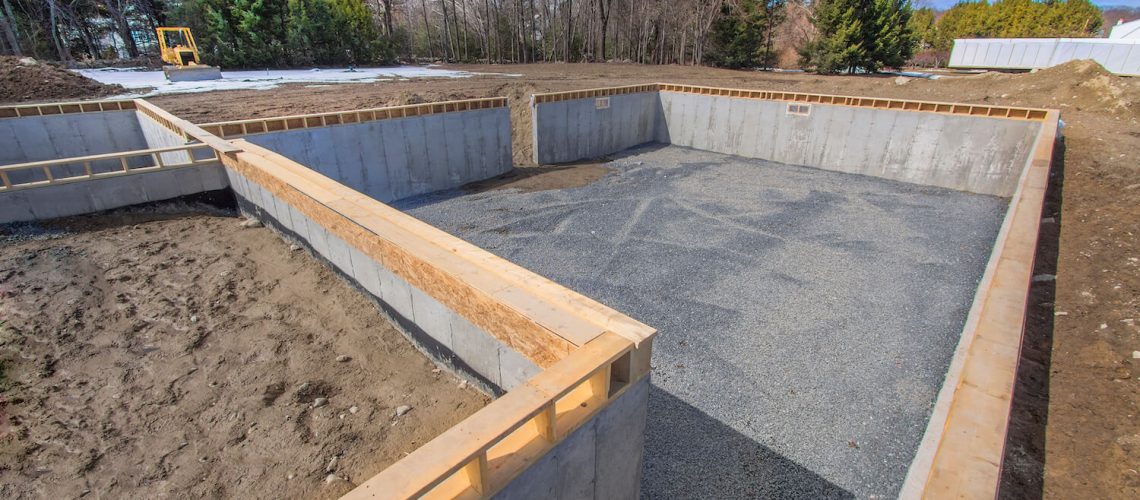When embarking on a new construction project, whether it’s a towering skyscraper, a suburban home, or an industrial facility, one element stands as the bedrock of success – the foundation. A solid foundation is the cornerstone upon which a building’s entire structure depends. It provides stability, longevity, and safety to the edifice that will rise above it. In this article, we will delve into the essential aspects of a professional new construction foundation, exploring the importance of proper planning, the materials used, construction methods, and the critical role it plays in the structural integrity of buildings.
The Crucial Role of Foundations
The phrase “built from the ground up” holds a profound truth in construction. The foundation is, quite literally, where everything begins.
Its primary foundation functions can be summarized as follows:
- Support and Load Distribution: The most fundamental purpose of a foundation is to support the weight of the entire structure above it. It must evenly distribute this weight to the ground, ensuring that the building remains stable over time.
- Stability and Settlement Prevention: Proper foundations help prevent settlement, which is the gradual sinking or shifting of a building. Without a stable foundation, a structure can experience differential settlement, causing cracks, structural damage, and even collapse.
- Resistance to Environmental Forces: Foundations must also resist external forces, such as wind, seismic activity, and soil movement. They anchor the building, preventing it from toppling or sliding.
- Moisture and Pest Control: Foundations act as a barrier against moisture intrusion and pests, safeguarding the building’s interior from potential damage.
Given these critical roles, it’s evident that the foundation is the most crucial element of any construction project. Ensuring its quality and durability is paramount to the long-term success of the structure.
Types of Foundations
Several types of foundations are used in construction, each selected based on factors like soil conditions, building design, and local building codes. The three primary types of foundations are:
- Slab-on-Grade: Slab-on-grade foundations are the simplest and most cost-effective type. They consist of a single, continuous concrete slab that rests directly on the ground. Typically used in residential construction, they are suitable for areas with stable soil and minimal frost depth.
- Crawl Space: Crawl space foundations involve a raised floor supported by a perimeter foundation wall. This type provides some access to the area beneath the building, making it suitable for homes in areas with high humidity or frequent flooding.
- Basement: Basement foundations are the deepest and most versatile. They provide a full-height space beneath the building, which can be finished and used as living space or for storage. Basements are common in colder climates, as they offer insulation benefits and protection against freezing.
The choice of foundation type depends on various factors, including the local climate, soil conditions, building design, and budget constraints. Regardless of the type chosen, all foundations share common principles in their construction for stability and longevity.
The Foundation Construction Process
Building a solid foundation involves a series of steps, each critical to ensuring its integrity and performance.
Here is an overview of the foundation construction building process:
- Site Preparation: Before any foundation work begins, the construction site must be cleared and excavated to the appropriate depth. Excavation must reach below the frost line to prevent frost heaving, a phenomenon where freezing soil can lift the foundation and cause damage.
- Footing Installation: Footings are wide, reinforced concrete pads that distribute the building’s weight to the soil below. They are placed at specific locations to support the load-bearing walls of the structure. Footings must be properly designed and constructed to bear the intended load and prevent settlement.
- Foundation Wall Construction: Foundation walls are typically made of concrete and serve as the vertical barrier between the building and the ground. They provide lateral stability and resist soil pressure. Proper reinforcement, formwork, and concrete quality are essential in ensuring the strength and durability of these walls.
- Drainage and Waterproofing: To protect against moisture intrusion, foundations are equipped with drainage systems, including weeping tiles or French drains. Waterproofing materials and coatings are applied to the exterior surface of the foundation walls to prevent water penetration.
- Slab or Floor Installation: Depending on the type of foundation, a concrete slab or crawl space floor is poured and finished. In the case of a basement, this floor may also serve as the basement ceiling, requiring additional attention to insulation and waterproofing.
- Inspections: Throughout the foundation construction process, inspections by building code officials or structural engineers are conducted to ensure compliance with safety and quality standards. These inspections help identify and address any issues before they become major problems.
- Backfilling: After the foundation is complete and inspected, the excavation around it is backfilled with soil. This backfilling process must be done carefully to avoid damaging the foundation or creating uneven pressure on the walls.
Foundation Materials
The choice of materials for a foundation is critical, as they directly impact its strength, durability, and resistance to environmental factors.
The most commonly used materials for foundation construction are:
- Concrete: Reinforced concrete is the predominant material for foundation construction due to its exceptional strength and durability. It can withstand the compressive and tensile forces that foundations are subjected to, making it an ideal choice.
- Rebar (Reinforcement): Steel reinforcement, commonly known as rebar, is embedded within the concrete to provide additional tensile strength. This reinforcement helps prevent cracking and enhances the overall structural integrity of the foundation.
- Masonry: In some cases, masonry materials such as concrete blocks or bricks may be used for foundation walls. These materials are durable and provide a suitable barrier against soil pressure.
- Waterproofing Membranes: To protect against moisture infiltration, waterproofing membranes, coatings, and sealants are applied to the foundation walls and floor. These materials create a barrier that prevents water from entering the building.
- Drainage Systems: Drainage components, such as weeping tiles, gravel, and drainage pipes, are essential for managing groundwater and preventing water buildup around the foundation.
- Gravel and Aggregate: Properly graded gravel or aggregate is used as a base material for footings and beneath concrete slabs. It aids in drainage and provides stability to the foundation.
The combination of these materials, along with meticulous construction techniques, ensures the foundation’s resilience and longevity.
Challenges in Foundation Construction
Building a solid foundation is not without its challenges. Several factors can complicate the process, potentially leading to structural issues if not addressed properly. Some common challenges include:
- Soil Conditions: Different soil types have varying load-bearing capacities and settlement characteristics. Proper soil testing is essential to determine the appropriate foundation design for the specific site conditions.
- Site Drainage: Poor site drainage can lead to groundwater infiltration and erosion around the foundation. Proper drainage systems are necessary to prevent water-related issues.
- Environmental Factors: Extreme weather conditions, such as heavy rainfall or frost, can affect foundation construction. Contractors must plan for adverse weather and take precautions to ensure the quality of the work.
- Existing Structures: In some cases, foundations must be constructed near existing structures or property lines. This can pose logistical challenges and require special engineering solutions.
- Local Building Codes: Compliance with local building codes and regulations is crucial to ensure the safety and legality of the foundation construction. Failure to meet code requirements can result in costly delays and revisions.
- Expansive Soils: Areas with expansive clay soils are prone to swelling and shrinking with changes in moisture levels. Foundations in these areas require specialized design and construction techniques to mitigate the effects of soil movement.
Addressing these challenges requires careful planning, engineering expertise, and adherence to best practices in foundation construction.
Importance of Professional Expertise
Given the critical role of foundations in construction, it’s evident that professional expertise is essential. Designing and building a foundation that will provide stability and durability for decades to come requires the following:
- Engineering Knowledge: Structural engineers are essential in the design phase, ensuring that the foundation is properly engineered to support the intended load and resist environmental forces.
- Construction Experience: Experienced contractors and construction teams are crucial for the execution of the foundation plan. They must follow industry best practices and workmanship standards to ensure the foundation’s quality.
- Quality Materials: The use of high-quality materials, including reinforced concrete and proper waterproofing components, is non-negotiable for a reliable foundation.
- Regular Inspections: Inspections by qualified professionals, including structural engineers and building code officials, are necessary to verify that the foundation meets safety and quality standards.
- Adherence to Codes and Regulations: Compliance with local building codes and regulations is mandatory. Professionals must stay updated on any changes in codes that may affect foundation construction.
- Site-Specific Considerations: Each construction site is unique, and professionals must consider the specific soil conditions, climate, and other site-specific factors in their design and construction processes.
In summary, the importance of professional expertise cannot be overstated when it comes to foundation construction. Cutting corners or compromising on quality in this crucial aspect of construction can lead to costly problems down the road.
The Cost of Cutting Corners
Attempting to save money by cutting corners in foundation construction is a risky endeavor.
The consequences of a poorly constructed foundation at home can be severe and costly, including:
- Structural Damage: Inadequate foundations can lead to structural damage, including cracks in walls, ceilings, and floors, which are not only unsightly but can also compromise the building’s safety.
- Moisture and Mold Issues: Poorly constructed foundations may allow moisture to seep into the building, leading to mold growth, wood rot, and a host of health and safety concerns.
- Settlement Problems: Without a stable foundation, a building may experience uneven settlement, leading to sloping floors, doors that don’t close properly, and other issues that affect functionality.
- Safety Hazards: In extreme cases, foundation failures can result in catastrophic building collapses, endangering the lives of occupants and causing extensive property damage.
- Costly Repairs: Remedying foundation problems after construction can be extremely costly and disruptive. It often involves underpinning, retrofitting, or even demolishing and rebuilding portions of the structure.
It’s evident that the potential costs and risks associated with cutting corners in foundation construction far outweigh any short-term savings. Professionalism, expertise, and adherence to best practices should always be the priority when laying the groundwork for any construction project.
Foundation Maintenance and Longevity
While professional construction is essential, ongoing maintenance is equally critical to ensure the longevity of the foundation. Regular inspections, drainage system maintenance, and addressing any cracks or issues promptly can prevent small problems from escalating into major structural concerns.
Additionally, building owners should be mindful of landscaping and grading around the foundation. Proper grading can direct water away from the foundation, preventing moisture-related issues. Landscaping features like trees should be planted at a safe distance from the building to prevent root intrusion that can damage the foundation.
Conclusion
A professional new construction foundation is the bedrock of any building’s stability and longevity. It plays a pivotal role in supporting the structure, resisting environmental forces, and protecting against moisture and pests. Whether it’s a residential home or a towering skyscraper, the foundation is the first and most crucial step in the construction process.
Choosing the right foundation type, materials, and construction methods is essential to ensure the safety and durability of the building.
It requires a combination of engineering expertise, quality materials, and adherence to local building codes and regulations.
Cutting corners in foundation construction can have dire consequences, including structural damage, moisture issues, settlement problems, safety hazards, and costly repairs. Investing in a well-constructed foundation and regular maintenance is the key to building structures that stand the test of time, from the ground up.

